by WITOLD RYBCZYNSKI
 Still from Lawrence of Arabia
Still from Lawrence of Arabia
A brief history of chairs
There is a pivotal early scene in David Lean’s film Lawrence of Arabia in which T. E. Lawrence and his superior, Colonel Brighton, visit the desert encampment of Prince Faisal, a leader of the Arab Revolt. The royal tent is spartan yet luxurious, patterned woven cloths hang from the low ceiling, a large brass samovar gleams in the candlelight, the ground is covered with a rich carpet. There is no furniture; the men sit on the carpet. Brighton, in his tailored uniform, polished Sam Browne belt, and riding boots, looks distinctly ill at ease with his legs awkwardly stretched out in front of him. Lawrence, a lieutenant and less formally dressed, appears slightly more comfortable, with his legs folded to one side. The prince, attired in a dark robe and a white ghutrah, reclines on a pile of sheepskins, while his colleague Sherif Ali leans casually against a tent pole. The various postures cinematically underline a central point: the relaxed Bedouins are at home in this place—the desert—while the stiff English colonel is an interloper. Lawrence is somewhere in between.
The world is divided into people who sit on the floor and those who sit on chairs. In a classic study of human posture around the world, the anthropologist Gordon W. Hewes identified no fewer than a hundred common sitting positions. “At least a fourth of mankind habitually takes the load off its feet by crouching in a deep squat, both at rest and at work,” he observed. Deep squatting is favored by people in Southeast Asia, Africa, and Latin America, but sitting cross-legged on the floor is almost as common. Many South Asians cook, dine, work, and relax in that position. Certain Native American tribes in the Southwest, as well as Melanesians, customarily sit on the floor with legs stretched straight out or crossed at the ankles. Sitting with the legs folded to one side—Lawrence’s position above—is described by Hewes as a predominantly female posture in many tribal societies.
The diversity of different postures around the world could be caused by differences in climate, dress, or lifestyle. Cold or damp floors would discourage kneeling and squatting and might lead people to seek raised alternatives; tight clothing would tend to inhibit deep squatting and cross-legged sitting; nomadic peoples would be less likely to use furniture than urban societies; and so on. But cause and effect does not explain why folding stools originated in ancient Egypt, a region with a warm, dry climate. Or why the Japanese and Koreans, who have cold winters, both traditionally sat on floor mats. Or why the nomadic Mongols traveled with collapsible furniture, while the equally nomadic Bedouins did not.
Hewes explained that he did not include the reclining position in his research because he did not find sufficient photographic evidence. That is a shame because reclining has always been a comfortable position for the body at rest. The ancient Egyptians used beds, and may have reclined on couches, although these do not appear in wall paintings—banquet scenes show people on chairs or sitting on the ground. The earliest pictorial evidence of dining in a reclined position is a seventh-century B.C. bas-relief in the British Museum. The alabaster carving sometimes called The Garden Party shows an Assyrian king and his wife being served food and drink outdoors—they are celebrating a victorious battle. The king is reclining on a couch that resembles a chaise longue, while the queen is seated nearby in an armchair; they share a table laden with food. What is unusual about the furniture is that it is very tall: the couch is about five feet off the ground, and the queen’s armchair, which reminds me of a lifeguard’s chair, is waist-high and requires a footstool. The reason for this height is to elevate the sitters above the servants, who wield fly whisks with handles as long as broomsticks to fan the royal couple. A ghoulish detail: the head of the king’s vanquished enemy hangs from a nearby tree.
The Paris Review for more
